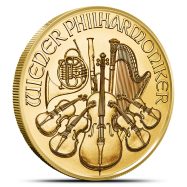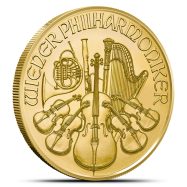

Like the Canadian gold maple leaf and the Krugerrand, the design of the Philharmonic coins, regardless of precious metal or weight, doesn’t change. Their first issue was so wildly popular that the Austrian Mint kept its original design untouched every year since 1989. Of course, the first gold Philharmonic coins were minted before Austria adopted the euro currency, so pre-2002 mintages have a face value of 2,000 Austrian schillings (abbreviated as öS or just S).
Since 2014, gold Philharmonic coins are regularly issued in five weights: the standard 1 oz and the “fractional” weights 1/2 oz, 1/4 oz, 1/10 oz and a miniscule 1/25 oz coin.
There were also two special and very limited issues: a huge 2009 20 oz. gold Philharmonic limited to just 6,027 total coins minted, and the supermassive 2004 1 kg gold Philharmonic called the “big Phil.” No, we don’t have any 1 kg gold Philharmonics in stock and if we did I’d buy one myself.
While variety is indeed the spice of life, the 1 oz gold Philharmonic has been a top-selling bullion coin year after year.
At first glance, you might think a building is featured on the Philharmonic’s reverse design. Perhaps the Viennese concert hall? Turns out, that epic structure you thought was architecture is really the Musikverein pipe organ. Found inside of the Golden Hall (Großer Musikvereinssaal) in the Innere Stadt neighborhood of Vienna, this truly incredible pipe organ is often used in performances by the Vienna Philharmonic. The organ is housed in an elaborate neoclassical case made of gilded wood – so when you look at the reverse of a gold Philharmonic coin, the colors are pretty accurate…
The obverse features inscriptions in German (the native language of Austria): Republik Oesterreich and Unze Gold 9999 or “Republic of Austria” and “1 ounce 0.9999 pure gold.” Face value (generally in euro) and mintage year also appear on the obverse.
A few years back, the team at CoinWeek got an unprecedented guided tour of the Austrian Mint! Their video is definitely worth watching:
The obverse of every Philharmonic minted since 1989 has showcased instruments used by the Vienna Philharmonic.
Specifically, a cello with two violins on each side make up the foreground. Behind, from left to right, are a French horn, a bassoon and a standing harp which represent the dozens and dozens of musicians who collaborate to perform absolutely breathtaking music.
Now, I know what you’re thinking: Where are the percussion instruments? You’re thinking strings, brass and woodwinds are all represented here – but what about the fourth family of classical musical instruments? Well, you may be surprised to know that standing harps are played by “percussing” the strings, and therefore are considered both a percussion and a string instrument! The things you learn when you work with coins all day!
You’ll also note the inscription Weiner Philharmoniker, or Viennese Orchestra in Austria’s native language, German.